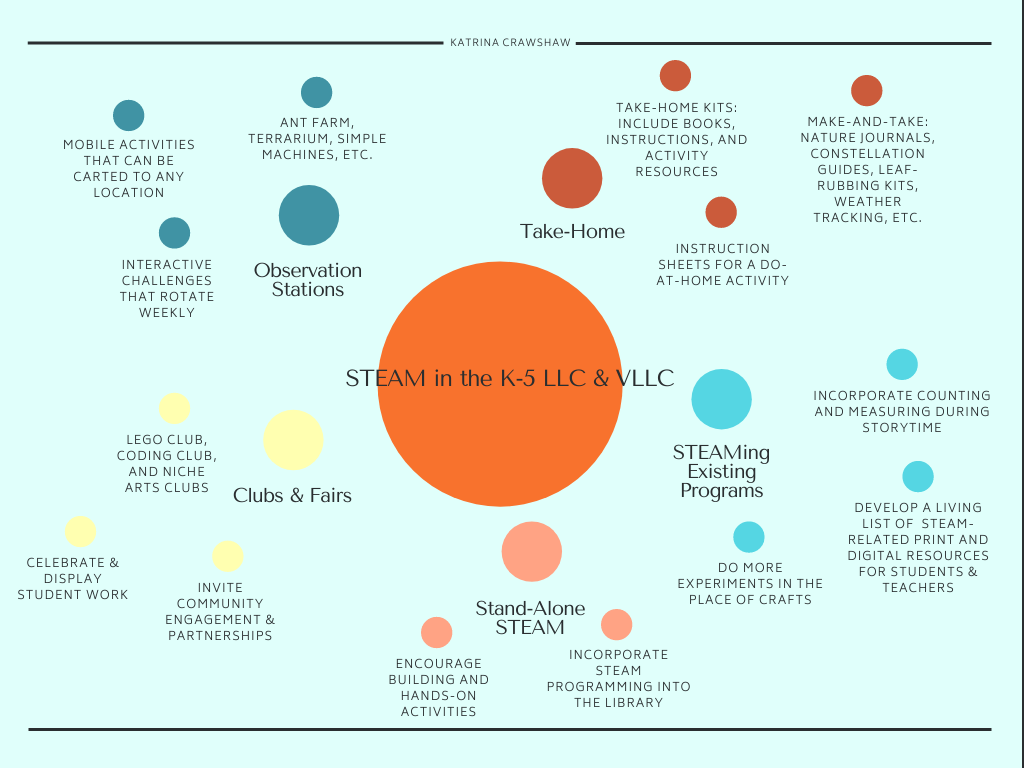
Reference:
KOESTER, A. (2014). Get STEAM Rolling! Children & Libraries: The Journal of the Association for Library Service to Children, 12(3), 22–25. https://doi-org.proxy.queensu.ca/10.5860/cal.12n3.22
Place-based teaching and learning in SD61

Reference:
KOESTER, A. (2014). Get STEAM Rolling! Children & Libraries: The Journal of the Association for Library Service to Children, 12(3), 22–25. https://doi-org.proxy.queensu.ca/10.5860/cal.12n3.22
The Horizon Report: K–12 Edition from New Media Consortium is something to keep visible for LLC goal development. With a focus on 21st Century tech implementation and leadership development, this report offers insight and applicable suggestions for LLC and VLLC growth that branches out to whole-school transformation. The latest report is 2017, which leaves me wondering when the next will be available.
I [admittedly] skimmed the contents of the 55-page report, with a strong focus on the trends, significant challenges, and timeline for adoption. Although I do not yet have my own LLC to root these goals and reflections, I focussed on a blend of the two Elementary-level school libraries that I have spent most of my time as a TTOC in.
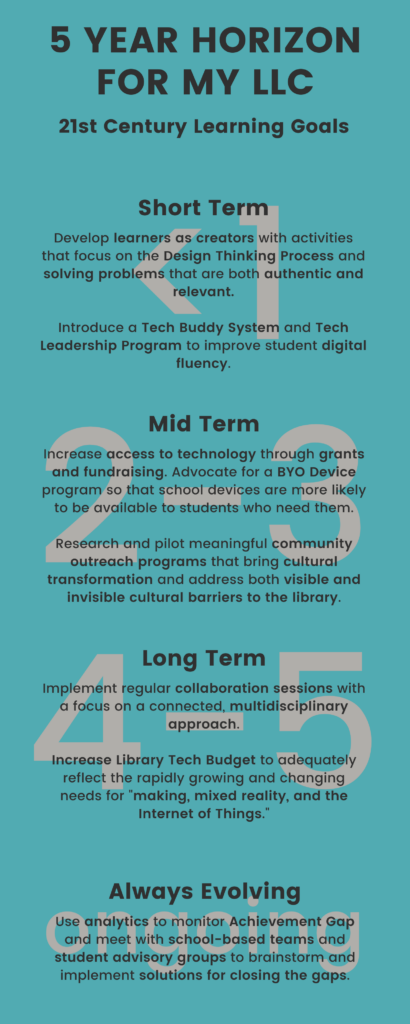
The Executive Summary (pg. 4) highlights 10 Big Picture ideas that underpin the 18 topics covered in the report: 6 key trends, 6 six significant challenges, and six developments in educational technology. I have based my LLC goals on these topics.
I have organized these based on my understanding of leveraging change in a complex system (thanks to Donella Meadows’ resources, referenced below). It is in harnessing and changing the “mindset or paradigm out of which the system — its goals, power structure, rules, its culture — arises” that we truly see transformational change happen. My longterm goal is always to close the Achievement Gap (p.34) and shift towards collaborative, hands-on, multidisciplinary learning.
Question for you: Which of these goals is most relevant to your LLC and how would you begin pursuing it? Are there any resources you would use to guide your implementation?
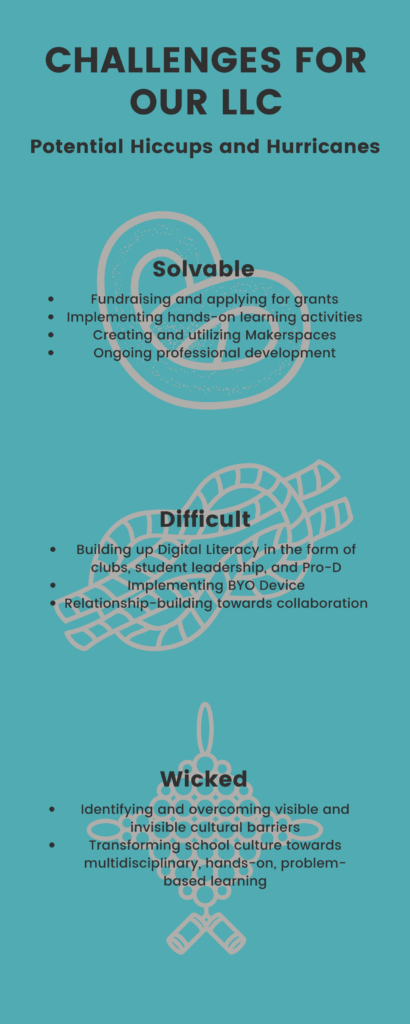
From Solvable to Wicked, what challenges might arise as we work along the 5-year LLC goals?
Some of these goals are immediately implementable. They do not present radical challenges to the mindsets of traditional thinkers, they follow pre-set educational norms, and are in-line with existing district goals. If they meet these criteria, they fall under Solvable.
The Difficult challenges refer to goals that might require a longer time-commitment to achieve and most likely involve challenging existing power structures. While still attainable, these challenges may require strategic conversations, a long-term focus, shifting mindsets, and a focus on re-education.
The final set of challenges are termed Wicked because they require digging deep into the Systems of Public Education here in BC. These challenges require an awareness of the roots of our policies, and how those roots are the very things that prevent social justice. Facing these challenges requires an Intersectional Analysis, comfort in discomfort, and a willingness to engage in introspective growth. It takes identity work, emotional awareness, cultural humility, and bravery. It’s wicked, but it’s worth it.
Question for you: Which of these presents the greatest challenge to you? How would you go about meeting this challenge, and what resources/tools/skills would you need to hone and harness along the way?
References:
Freeman, A., Adams Becker, S., Cummins, M., Davis, A., and Hall Giesinger, C. (2017). NMC/CoSN Horizon Report: 2017 K–12 Edition. Austin, Texas: The New Media Consortium.
Meadows, D. (2012, April 5). Leverage Points: Places to Intervene in a System. The Academy for Systems Change. https://donellameadows.org/archives/leverage-points-places-to-intervene-in-a-system/.
Strauss, V. (2019, April 18). What the modern world has forgotten about children and learning. The Washington Post. https://www.washingtonpost.com/news/answer-sheet/wp/2016/08/19/what-the-modern-world-has-forgotten-about-children-and-learning/.

Apparently, according to the BC Curriculum, children in grades K-5 are too young to learn Computational Thinking and Robotics. Or at least, anything explicitly called that. When I enter those search terms into the Search Curriculum page, with parameters set to K-5, I’m given nothing! When I remove the parameters, I see that the terms begin showing up in Grade 6 and are most predominant in Secondary grades. What a disappointment!
But what is computational thinking (CT) and how does it link to robotics? Is it possible that these skills are, in fact, taught at the K-5 levels, though not explicitly called that?
According to the CodeBC Computational Thinking Illustrated, when we engage in CT what we are doing is “specifically looking at what happens when we collect, store, and process data…. we take note and measure how data is transformed. We look at how information is processed and what is accomplished by that processing.” Another big part of CT is actually getting our hands busy by building and producing computational artifacts – like machines or robots. In other words, when we engage in CT, we do things like ideate, build, tinker, observe, and reflect. Now this is starting to sound like familiar curriculum for K-5.
When engaging in CT, we are also building skills in abstraction. One of the ways this is done is by building models – separating out the qualities we care about and leaving the rest. According to CodeBC, “when we deliberately separate our system into parts that can be individually understood, tested, reused, and substituted, then we are creating new abstractions.” Models can be physical objects or something less tangible, like a computer program. It takes time to learn how to narrow the margins and scope of a model so that the variables are measurable – create something without boundaries and you’ll “end up simulating the whole world!“
In CT, we are also guided to build skills in analysis, problem-solving, and communication (with machines, computers and humans). The answers we get after analyzing results may not always be obvious to others, and so it is our task as computational thinkers to figure out how to translate our findings into clear and accessible terms. Inversely, we may have an idea that we want to test out and we must also learn to translate our ideas into CT: coding, programming, machinery, etc.
In K-5, we are asked to build and analyze models, solve simple and complex problems, and learn how to communicate with ourselves and others. A great deal of this is done through play and scaffolding emerging scientific, mathematical, social, physical and creative thinking skills.
Team-work is another skill developed with CT. CodeBC reminds us that “building any complex system, software or hardware, requires more work be done in less time than any single person can accomplish.” Adding more people isn’t the magic recipe, however; “interpersonal and communication skills as well as knowledge of different team methodologies and processes” are vital to effective teamwork, as is good management as teams expand.
As it turns out, we are continuously developing CT skills at the K-5 level; it’s just not explicitly called CT. Being aware of the end-goal might be helpful for teachers who are introducing the skill-building exercises that will prepare children to become computational thinkers.
So, what are some explicit ways we can engage in CT?
Decomposition is one. Taking apart objects or breaking down a process into individual steps, like Josh Darnit does in his PB&J Exact Instructions Challenge:
Primary teachers are very familiar with another exercise in CT: pattern recognition. According to CodeBC, “forming an idea of what you expect is one way to find patterns. The more you look, the more patterns you will find in nature, in computational artifacts, and in processes. When we recognize a pattern, we can use our other computational thinking skills to help us understand its importance.“
Once we start to find and recognize the patterns that surround and are within us, we must learn to describe the patterns we see with precision. For this, we learn pattern generalization and abstraction. When generalizing, we look for similarities or commonalities in a group of patterns and we try to describe them in a way that is both clear and efficient. When we learn to describe a group of patterns, or a pattern of patterns, all at once, then we have an abstraction.
Finally, CT skills can be explored using algorithm design. While some algorithms are computer programs, it’s fair to say that an algorithm is more like an idea. In order to design an algorithm, you need to think about what you want to accomplish (your goal), and what tools and limitations you have (the constraints of the system). CodeBC says that designing an algorithm that “accomplishes specific goal within the constraints of the system is like creating an elegant dance that everyone else wants to learn.” Just like a dance, this is a process that can be explored, played with, and scaffolded in K-5.
So, what do CT and robotics have in common? CT is the framework we need in order to engage in robotics. It is the exploration and skill-building of language, patterning, process, and thinking that makes something like robotics possible. While “Computational Thinking” and “robotics” may not show up in the K-5 BC Curriculum, the foundational building blocks are there: analyzing, communicating, ideating, pattern-recognition, problem-solving. We just have to learn how to read the language of CT and remember to begin with the end in mind.
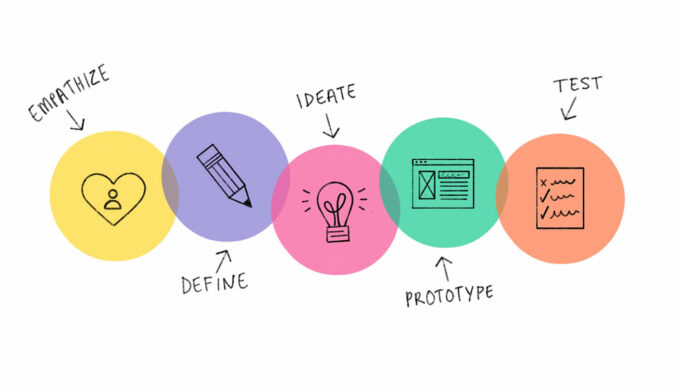
Problem: Teachers have not grown out of the traditional view of the library as a place to retrieve books.
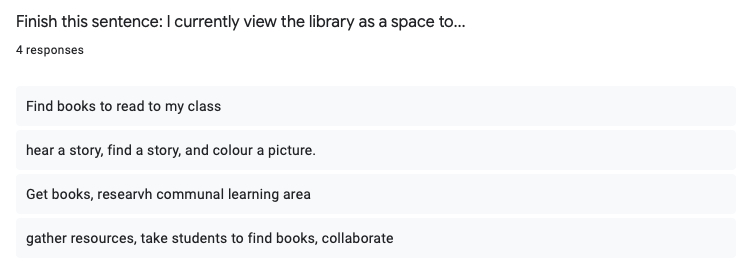
Reframe: Teachers with traditional views of the school library are underutilizing the space.
Developing relationships with teachers and administrators in order to reframe their existing understanding of the purpose of the library will help in the process of transforming school libraries into 21st century library learning commons (LLCs). Ample research supports that a LLC has direct correlations to improved student achievement and lifelong learning skills. (CSL, 2020)
Problem: Inflexible library scheduling prevents open access to resources like the Makerspace.
Currently, the library operates on a schedule, with classes rotating in as the TL covers prep times throughout the day. There are very few “open blocks” where students and teachers can informally use the space for pleasure reading, group work, teacher/TL collaboration, events, etc. The positioning of the Makerspace within the library also means that students and teachers are not able to access the materials whenever they need or want them.
Reframe 1: Inflexible scheduling prevents open access to library resources.
Changing the library scheduling from fixed to flexible (or “mixed”) has a proven positive effect on student achievement (Haycock, 2002), and may allow the library to become more accessible to the flexible and diverse needs of students, teachers, and classes. By integrating a flexible schedule, the library space can then be used as it is needed. It is important to develop strong relationships with classroom teachers, administrators, and students so that they know to use the library as a research tool, a collaborative space, and a safe zone for self-regulation (Needham, 2003).
Reframe 2: A fixed Makerspace is not always accessible, given library scheduling constraints.
There are certainly advantages to having a permanent Makerspace, especially when library scheduling is flexible and allows students access to the space whenever inspiration strikes. Creating a mobile Makerspace allows teachers to bring the cart to their own space, reduces some accessibility challenges, and can also be a solution in schools with limited library physical space and budget (Craddock, 2015) (YALSA, 2014).
Let’s Focus:
I am going to focus on designing a mobile makerspace, because I think this is a challenge that many schools face. My hope is that the solutions to this challenge can be implemented immediately so that schools can benefit from the skills and processes developed when engaged in the design thinking process.
Design Challenge
Design a mobile, or pop-up, Makerspace that fits your school library budget, facilitates students using the design thinking process, and can be easily carted from one classroom to another. Be sure to include a plan for tracking and replacing materials as they are used, as well as a booking schedule so that teachers can easily reserve the cart as needed.
References:
Craddock, I. L. (2015). Makers on the move: a mobile makerspace at a comprehensive public high school. Library Hi Tech, 33(4), 497–504. https://doi.org/10.1108/LHT-05-2015-0056
Canadian School Libraries (CSL). 2020. “Leading Learning: Standards of Practice for School Library Learning Commons in Canada.” Available: http://llsop.canadianschoollibraries.ca
Haycock, K. (2002). Flexible scheduling revisited. .(Brief Article). Teacher Librarian (Vancouver), 29(3), 6–.
Needham, J. (2003). From fixed to flexible: making the journey. Teacher Librarian (Vancouver), 30(5), 8–.
YALSA. (2014). Making in the Library Toolkit: Makerspace Resources Task Force (p. 8-9, 37).
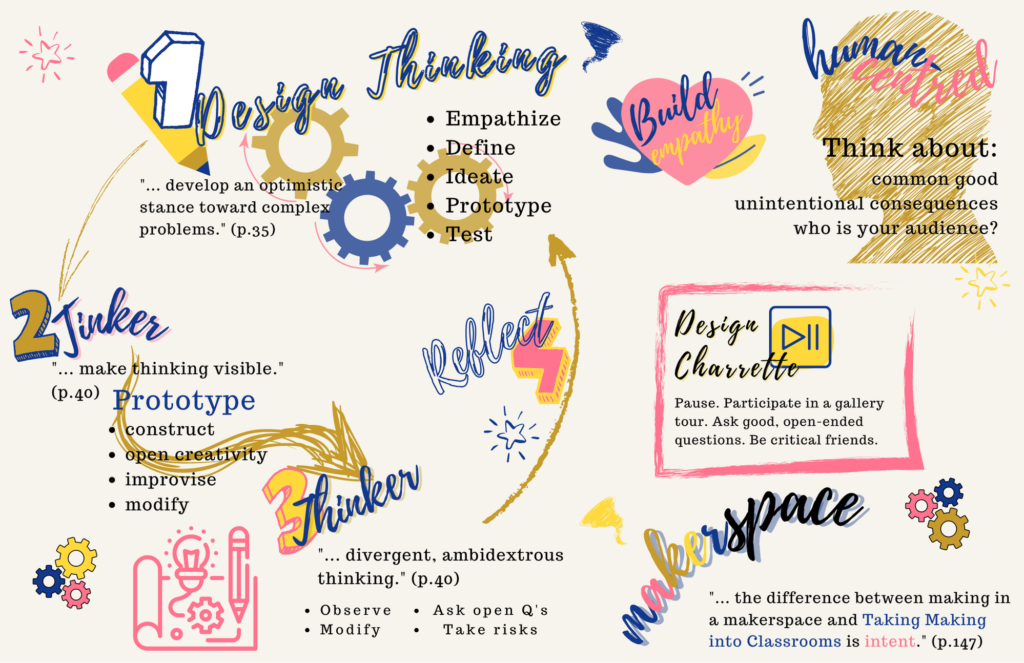
References:
Taking Making Into Classrooms: A Toolkit for Fostering Curiosity and Imagination
Canva for Educators (sign in using your district email to unlock free features!)
© 2025 Learning in Place
Theme by Anders Noren — Up ↑
Recent Comments